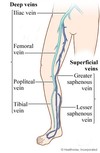Haemostasis and Clotting Flashcards
What is haemophilia C
- Jewish populations - Autosomal recessive

What is deep vein thrombosis?
- when there is a clot in the deep vein of your legs,
What are the compounds secreted by thrombocytes when they are activated, and what do each of them cause?
- ADP: activate platelets further
- Serotonin: vasoconstriction
- Thromboxane A2 (TxA2): vasoconstriction and aggregation
- Calcium and presence of phospholipids: allows coagulation reactions
What are the compounds that initiate the internal and external coagulation cascades?
- Extrinsic (tissue factor) pathway: involves tissue factor
- Intrinsic (contact activation) pathway: thrombin, factor XIIa, a nucleation site, glass in a laboratory
What are the enzymes directly responsible for transforming fibrinogen to a clot
- Prothrombin –> Thrombin: converts fibrinogen into fibrin
- Factor XIIIa, cross-links it into a clot
What are the enzymes that are only part of the intrinsic (contact activation) coagulation pathway?
- factor XI
- factotor XII
- factor IXa
What is the role of vitamin K in haemostasis?
- necessary for the production of Ca-dependent proteases in the liver - i.e factor II, VII, IX, X (extrinsic tissue factor pathway)
What physiological state might lead a patient to develop a vitamin K deficiency?
- lack of bile salts, if exogenous lipids were not being properly digested
- Warfarin toxicity: prevents recycling of vitK
What is the aetiology of haemophilia A
- a mutation in the factor VIII gene
- X-linked recessive disease
What is the aetiology of haemophilia B?
- X-linked recessive - a mutation in the factor IX gene
GIve an overview of how the body responds to an injury in a blood vessel
- formation of a haemostatic plug physically protects and coats the surface of the injury initially: platelet adhesion, activation and aggregation - coagulation - vasoconstriction: decreases local blood flow
Explain the role of platelets in haemostasis?
- aggregate at the site of injury, over fibrinogen, forming a haemostatic plug - contribute to vasoconstriction by releasing vasoconstrictor compounds, serotonin TxA2 - secrete/provide compounds that encourage coagulation, including the phospholipids
List 4 differentiated cell types that develop from the lymphoid precursor cells
- B cells - T helper cells - NK cells - Plasma cells
List 4 differentiated cell types that develop from the myeloid precursor cells
- eosinophils - monocytes/macrophages - neutrophils - RBC
Explain platelet activation
- change dramatically in response from ADP or exposed collagen
- more spindly shape
- metabolism goes up
- exocytose many granules
- their membranes gain proteins (GP2b/3a)
- many reactions of the clotting cascade can only take place on the membrane of an activated platelet
- platelet aggregation can only occur on the surface of already activated platelets
What prevents blood from clotting spontaneously and inappropriately?
- Fibrinolysis.
- Anticoagulation factors.
- Maintaining platelets in the inactivated state.
- Keeping coagulation initiation signals sequestered (eg Factor III/Tissue factor behind the endothelium).
- Rapid blood flow
What is Factor X and Xa?
- Factor Xa is an activated enzyme. It catalyses the conversion of prothrombin (factor II) to thrombin. Its activity is substantially increased when it combines with active factor five.
- Factor X is the inactive form of Factor Xa
What is Xase?
- converts Factor X to Xa
- Intrinsic Xase is Factor IX + factor VIII,
- Extrinsic Xase is Factor VII + tissue factor
What are the causes of bleeding?
- Vascular disorders
- Platelet disorders: thrombocytopenia, defective function
- defective coagulation: inherited v acquired
where does the blood go
What are the different patterns of bleeding?
Vascular and platelet bleed cause:
- bleeding into mucous membranes and skin
Coagulation disorders cause:
- bleeding into joints and soft tissue
Give examples of Inherited and acquired vascular bleeding
Inherited:
- Hereditary haemorrhagic telangiectasia (Oslo-Weber-Render syndrome), abnormal blood vessel formation, autosomal dominant
- Ehlers-Danlos syndrome: affects connective tissue
Acquired:
- Scurvy
- Steriods: corticosteroids in GI bleeding
- Senile
What is the normal platelet count range?
- 150-400 x 109/L
- below 150 is thrmobocytopenia
- symptoms are seen when plts are <10





